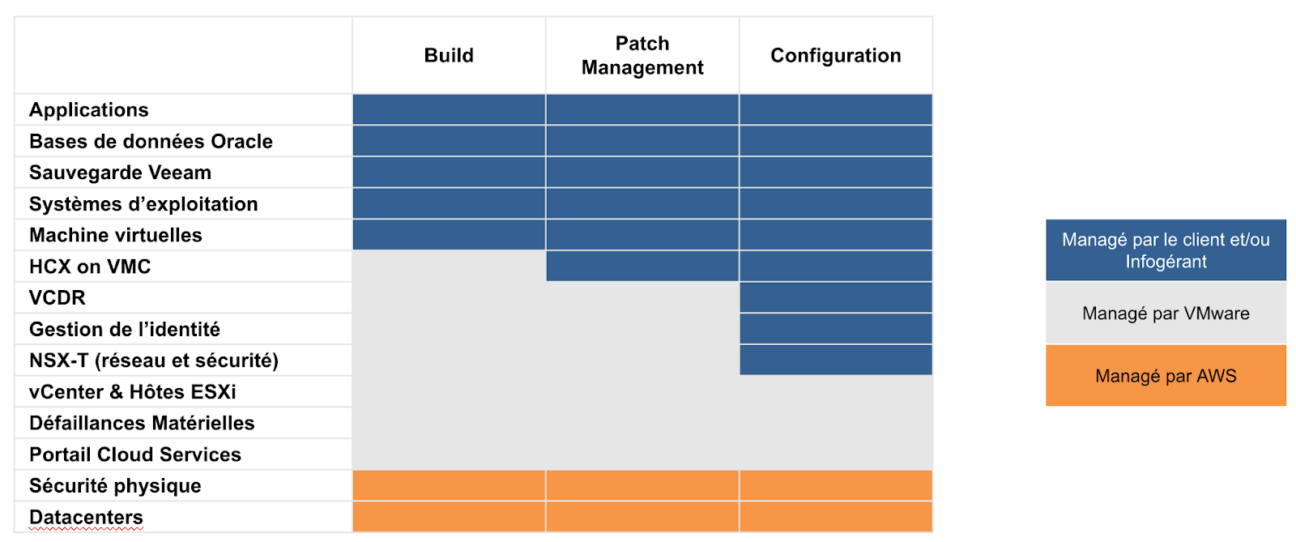Synergie is an international group (French leader and fifth European group) that offers businesses and institutions a comprehensive range of services in managing and developing Human Resources. Its global network consists of 4,600 collaborators in 17 countries. The company migrated part of its fleet to the AWS Cloud and VMware Cloud on AWS to implement solutions better suited to its IT infrastructure needs. The migration, lasting six months, covered 25 applications and 170 VMs.
A brief presentation of VMware Cloud
A brief presentation of VMware Cloud
VMware Cloud on AWS provides dedicated, non-shared cloud infrastructure, supporting vSphere clusters containing up to 16 hosts running on next-generation AWS “bare metal” infrastructure, based on EC2 instances optimised for storage, and featuring low-latency NVMe (Non-Volatile Memory Express) based SSDs.
The basic configuration is two hosts per SDDC; the cluster’s capacity can expand to 16 hosts. VMware Cloud on AWS runs on the VMware Software-SDDC (Software-Defined Data Center) stack directly on the host servers without nested virtualisation.
Creating new VMware SDDC clusters on the AWS cloud is quick and can be achieved using a web console or the RESTful API. VMware manages and operates the service, including the components of the VMware SDDC software. VMware provides scheduled SDDC software updates and urgent software patches with notifications and automatic resolution of hardware failures. Below is a macro explanation of the shared responsibility model:

The main benefit of this solution is the reduction in migration costs. Existing workloads on your VMWare environments in data centers can be migrated to VMware Cloud on AWS through a live migration, without service interruption, transparently for the user. If the technical prerequisites (N2 network extension, HCX installation on source infrastructure, etc.) are not completed, or this migration method is not desired, a “cold” migration is available.
Customer Testimonial: Yann Le Clec’h
Why migrate to AWS? And why to VMware Cloud?
Synergie was used to operating on cycles of 4 to 5 years to reconsider its infrastructures, analysing the needs for the next five years, with a margin including the requirements that would be identified later. This approach led to oversized infrastructures at the beginning of the cycle, which often needed to be supplemented at the end of the process. The interest with VMware Cloud is to have the required capacity for the current period and to be able to extend it when necessary quickly.
Moreover, we had acquired significant skills in VMware technologies, and we wanted to capitalise on this expertise by choosing VMware Cloud on AWS. Learning related to AWS Cloud and IaC is essential and significant for the Ops teams. The benefit of adopting a VMC solution is to reduce this effort on other teams.
What was the scope?
The migration scope was 170 VMs spread across 20 ESXi in 2 data centers. These VMs hosted infrastructure components, applications, and a Citrix environment. A client/server application that made direct (without cache) queries on a DB2 hosted on an IBM Power I (AS/400) had deficient latency requirements that did not allow the Citrix farm to be migrated. The project was initiated in 2021 with:
- a solution choice ratified in March/April,
- project planning before the summer,
- the design and construction of the infrastructure, security, and network topology from July to October,
- a first POC (Proof of Concept) in October,
- and a project that ended in January 2022. This schedule could have been achieved in 5 months without the difficulties related to the client/server application. Indeed, latency issues (independent of the VMC solution) identified between certain x86 and AS400 applications partially reduced the scope eligible for migration.
What hosting models today?
Synergie currently operates applications on three parallel models:
- in its data centers,
- on VMware Cloud on AWS,
- on AWS natively. The payroll/billing application (RPG/DB2) that remained in the data centers is controlled, and the client-server application that uses the DB2 database will only evolve to ensure the required security level but will disappear within two years. The applications on VMware Cloud on AWS are operated thanks to our VMware expertise. We had to ramp up skills more quickly than expected on applications in the native AWS environment compared to the contribution of managed AWS services to meet our business needs.
What was the value contribution of the migration for Synergie?
The first value contribution of the migration is that the development teams were not solicited and could continue to work on the functional evolutions of the applications during the migration. This was utterly “painless,” as there was no production stoppage. The second contribution is using 80% of the capacities, compared to the on-premise situation, where we were at 30%. In 12 minutes, we can add a host and an actual project (order, receipt, installation, and implementation). The third contribution that could be observed is the simplicity of managing the VMC. We had to upgrade the ESXi that remained in our data centers, and the difference in difficulty between this on-premise “upgrade” and the 2 to 3 VMC updates, which were utterly transparent, strengthened our choice. The fourth contribution that appeared earlier than expected: AWS managed services allowed POCs to be set up to meet business needs in a few weeks. The last (indirect) contribution is related to moving to new technologies, which brings additional motivation to the teams and facilitates the recruitment of new talents.
What choices did you make in terms of reversibility and sovereignty?
We experimented with reversibility regarding the Citrix farm that was migrated to VMware Cloud on AWS; then, we came back on-premise. This operation was carried out very quickly for the 40 VMs of the farm. For AWS services, reversibility must be studied service by service. From a sovereignty point of view, there was a vital requirement for data localisation in France, which was one reason for choosing VMware Cloud on AWS over competing solutions. Everything is hosted in the AWS Paris region.
What advice would you give to start a migration?
Devoteam Revolve convinced us of Terraform’s contribution to deploying and upgrading the infrastructures. The experience of a few months has confirmed the gains of this approach. However, this has constituted a fundamental cultural change for our teams, particularly the network and security teams. It is essential to correctly anticipate training and plan the necessary support for this evolution, as we were able to do with Devoteam Revolve.
The vSAN storage space of VMWare Cloud on AWS is linked to the number of nodes in the SDDC cluster. Today, to add storage space, you have to add a node to the cluster (Note: this limitation should be lifted with the VMWare Cloud Flex Storage solution, which was announced in preview by VMWare in March, and which will allow the addition of storage space without adding any additional host). This introduces a threshold effect regarding FinOps that should be well anticipated.
FinOps mastery is essential with a 3-year commitment model we have chosen for VMWare Cloud on AWS and the on-demand default model on essential AWS services, complemented by savings plans. Planning for half a day per week is necessary to review the figures and work on financial optimizations.
It is also crucial in the analysis of the application portfolio for migration to understand well the applications that will be extremely sensitive to latency, either to partition the migrations or if specific components remain on-premise, as in our case, to avoid migrating particular applications.
What are the long-term strategy and ambitions for tomorrow thanks to AWS Cloud?
Synergie uses the VMC solution as a springboard for adopting native AWS solutions while benefiting from immediate operational gains. Projects on data are in the pipeline, and Synergie identifies only an AWS target for multiple reasons (highly scalable platform, native tools/services available, etc.).
